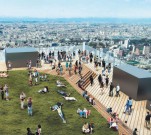Overlooking the Mount Fuji

In European cities, train stations, as a rule, are the centers of long-distance transport with surrounding transit terminals. Station platforms and passenger loading premises, as a rule, are fairly large areas, where passengers can spend a lot of time. At the stations in Tokyo, such complexes are transportation and transfer hubs for intercity transport. People use these infrastructure facilities every day on the way to work, school, etc. Naturally, the transfer from one line or transport mode to another need to waste a minimum of time, so the smooth operation of transit systems is very important.
Shibuya station is one of Tokyo’s largest intra-city transit hubs. The Shibuya Station Block Redevelopment Project is a project that will develop the station facilities to enhance convenience and promote urban development. At the same time, it is a mixed-use development project that will create a new cultural and commercial center in Shibuya, Tokyo’s cultural trendsetter. Shibuya, the renowned heart of young fashion and culture in Japan, is a large valley, and at the bottom of that valley is a hub for transferring between public transit systems, centering on the station.
With a reputation of being one of the most dynamic railway stations in the world, as many as 1 million passengers get on and off at Shibuya station daily. It is the node for six railway stations and eight lines of the Japan Railways group and four private railway lines (Tokyu, Tokyo Metro, Keio). Integrated with the adjoining bus terminal, which is one of the largest in Tokyo, its high public transit functions have supported the vibrancy of Shibuya for many years.
Shibuya Station is a railway station in Shibuya, Tokyo, operated jointly by East Japan Railway Company (JR East), Keio Corporation, Tokyu Corporation, and Tokyo Metro. With 2.4 million passengers on an average weekday in 2004, it is the fourthbusiest commuter rail station in Japan (after Shinjuku, Ikebukuro, and Osaka / Umeda) handling a large amount of commuter traffic between the center city and suburbs to the south and west.
Meanwhile, however, the station facilities have become increasingly complicated as they underwent repetitive extensions and reconstruction in pace with rapid urban development, and this is detracting from convenience of the users. In recent years, the safety and disaster resilience of the aging facilities have also come to be questioned.
Full content of this issue you can read here
The full version of the article can be read in our printed issue, also you can subscribe to the web-version of the magazine
 Materials provided by Nikken Sekkei
Materials provided by Nikken Sekkei


